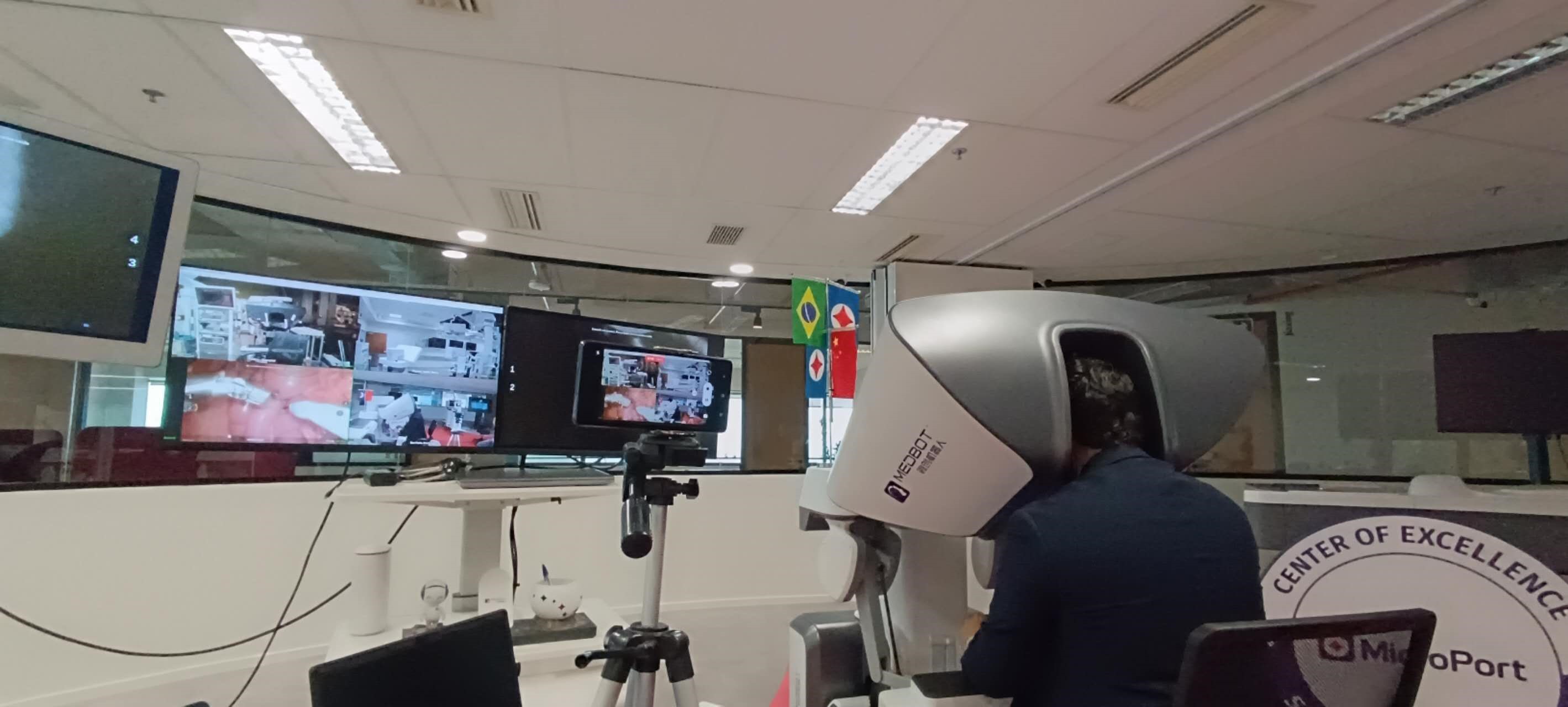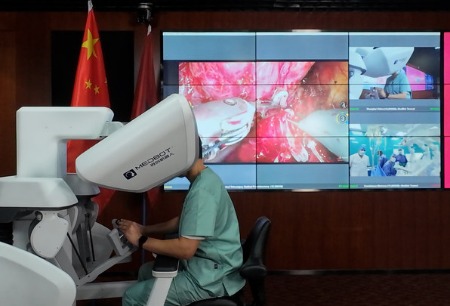On September 3, 2024, Beijing time, the Toumai® four-arm laparoscopic surgical robot successfully assisted Professor Patel(Chairman of the Global Robotic Surgery Association)'s team, led by Dr. Marcio, in completing South America's first 5G tele-surgery demonstration. This groundbreaking operation was conducted using the Toumai® surgeon console in São Paulo, Brazil, to remotely control a patient cart located 6700 kilometers away in Orlando, USA, successfully performing bilateral partial nephrectomy. This achievement marks a significant breakthrough in the global tele-surgery field by Toumai® and serves as a milestone and successful model of international cooperation in making global medical services a reality.

Partial nephrectomy (NSS surgery) allows for complete tumor removal while maximizing the preservation of normal renal parenchyma, achieving a dual benefit of "survival time" and "quality of life" for kidney tumor patients. However, due to the rich blood supply to the kidneys, prolonged interruption of renal artery blood flow can cause irreversible damage to kidney function. Thus, even when performed locally, this surgery is highly challenging, requiring not only the surgeon's skilled techniques but also the robot's stable performance to precisely execute intricate operations in a confined surgical space, ensuring timely completion of tumor removal and wound suturing.

In addition to the inherent surgical difficulty, network latency and instability pose major challenges to tele-surgery. In this transnational long-distance surgical demonstration, the Toumai® robot utilized its core self-developed ultra-low latency image transmission technology and advanced adaptive dynamic latency compensation algorithm to achieve high system stability and precision under ordinary network conditions, with no noticeable delay throughout the process and one-way network latency of less than 60 milliseconds (a human blink takes about 300-400 milliseconds). Dr. Marcio expertly operated, successfully dissecting both kidneys, exposing the renal hilum vessels, clamping the renal artery, accurately locating the tumors, and excising them with a 0.5 cm margin to reduce the risk of positive margins.
The renal pelvis and parenchyma were then meticulously sutured in layers, and blood supply to the kidneys was restored with no significant bleeding at the surgical site. The entire procedure was smooth and seamless, with a warm ischemia time of only 15 minutes per kidney. Postoperatively, the patient's renal function was normal, and vital signs were stable.
The expert team involved in this remote surgical animal experiment highly praised the procedure. Dr. Marcio stated that the surgery was smooth with minimal blood loss, and the Toumai® robot demonstrated excellent operability, flexibility, and responsiveness, with no perceived delay or lag during the procedure. This successful tele-surgery, spanning such a vast distance, marks a memorable moment in the history of Brazilian surgery.
According to reports, most hospitals in São Paulo currently remain at the "digital hospital" and "smart clinic" levels of informatization, mainly providing basic services such as registration, guidance, billing, and medical record management. Remote medical services in some large public hospitals are limited to common and chronic disease follow-ups and "Internet+" family doctor contract services via network video and mobile communications, with tests, injections, and surgeries still requiring offline completion. "The successful completion of this cross-border surgery will change this situation! Patients in critical condition or in remote areas can receive timely treatment from high-level doctors through 'tele-surgery,' advancing the level of remote medical services in Brazilian healthcare institutions to a higher level!"
Dr. He Chao, President of MicroPort®MedBot® Group, stated, "MicroPort®MedBot®, with globally leading remote integration technology innovations, has overcome large-scale application challenges without relying on dedicated lines or single suppliers, truly crossing the threshold of comprehensive commercialization of tele-surgery. With globally leading remote safety assurance technologies such as dual-machine hot backup, data encryption, and real-time monitoring, we have solved the continuity issues of clinical surgery, achieving the world's only large-scale, multi-region, long-distance complex surgery clinical applications. We look forward to further international cooperation to extend remote robotic surgery to medically underserved countries or regions, making tele-surgery safer, more convenient, and efficient through technological innovation, and providing high-level medical services to local patients, truly realizing 'Making surgeries easier, safer and less invasive.'"









 Hu ICP Bei No. 20013662 HGWA Bei No. 31011502015178
Hu ICP Bei No. 20013662 HGWA Bei No. 31011502015178 " are registered trademarks of Shanghai MicroPort Medical (Group) Co., Ltd.” . They have been authorized to be used by Shanghai Microport Medbot (Group) Co., Ltd., and no other party shall use such trademarks without prior written permission thereof.
" are registered trademarks of Shanghai MicroPort Medical (Group) Co., Ltd.” . They have been authorized to be used by Shanghai Microport Medbot (Group) Co., Ltd., and no other party shall use such trademarks without prior written permission thereof.
